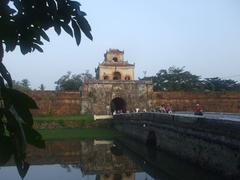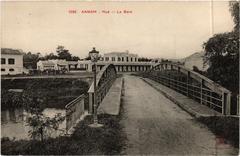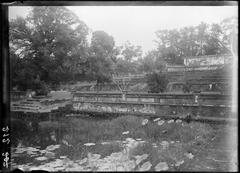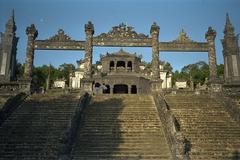
Huong Dan Toan Dien Tham Quan Ho Thuy Tien, Hue, Vietnam
Ngay Thang: 23/07/2024
Gioi Thieu
Hồ Thuỷ Tiên, also known as Thuy Tien Lake, is an enigmatic and hauntingly beautiful abandoned water park located in the Thuy Bang Commune, Huong Thuy Town, approximately 10 kilometers southwest of Huế, Vietnam. Initially established in the early 2000s as a grand tourism initiative, the park was meant to be a bustling hub of entertainment with an array of attractions such as an aquarium, water slides, and a wave pool. However, due to financial hurdles and poor visitor turnout, the park was abandoned by 2008 (Atlas Obscura). Despite its short-lived operational stint, Hồ Thuỷ Tiên has since become a magnet for urban explorers, photographers, and adventure enthusiasts, drawing them in with its eerie, decaying structures and the striking dragon sculpture that looms over the lake (CNN Travel). This guide aims to provide a comprehensive overview of Hồ Thuỷ Tiên’s history, practical visiting tips, and its modern-day significance, offering readers a well-rounded understanding of this unique destination.
Muc Luc
- Introduction
- History of Hồ Thuỷ Tiên
- Origins and Construction
- Operational Challenges and Decline
- Rediscovery and Modern-Day Significance
- Practical Visitor Information
- Visiting Hours and Tickets
- Travel Tips
- Nearby Attractions
- Cultural and Historical Context
- Future Prospects
- FAQ
- Conclusion
Exploring Hồ Thuỷ Tiên - History, Visiting Tips, and Modern-Day Significance
History of Hồ Thuỷ Tiên
Origins and Construction
Hồ Thuỷ Tiên was initially conceived in the late 1990s as a grand tourism project. Construction began in 2000, funded by the Hue Tourism Company with an estimated investment of around $3 million USD. The park officially opened in 2004, featuring a variety of attractions including an aquarium, water slides, a wave pool, and a large amphitheater. The iconic dragon sculpture encircling the aquarium remains one of its most recognizable landmarks (Atlas Obscura).
Operational Challenges and Decline
Despite the initial excitement, Hồ Thuỷ Tiên faced numerous operational challenges. Visitor numbers were lower than anticipated, and the park struggled to generate sufficient revenue. By 2008, the park was largely abandoned, with nature gradually reclaiming the structures (The Culture Trip).
Rediscovery and Modern-Day Significance
In recent years, Hồ Thuỷ Tiên has become a popular destination for urban explorers, photographers, and adventure seekers. The dragon sculpture, in particular, offers panoramic views of the area and serves as a poignant reminder of the park’s ambitious beginnings. The park’s current state highlights the impermanence of human endeavors and the power of nature to reclaim man-made structures (CNN Travel).
Practical Visitor Information
Visiting Hours and Tickets
As an abandoned site, Hồ Thuỷ Tiên does not have official visiting hours or ticket prices. Visitors often explore the park at their own risk, and it’s advisable to go during daylight hours for safety.
Travel Tips
- How to Get There: The park is located about 10 kilometers southwest of Huế. It is accessible by motorbike, taxi, or bicycle.
- Safety: The structures are in a state of disrepair, so exercise caution when exploring.
- Best Time to Visit: Early mornings or late afternoons offer the best lighting for photography.
Nearby Attractions
While in Huế, consider visiting other historical sites such as the Imperial City, various pagodas, and royal tombs. These landmarks offer a deeper understanding of the region’s rich cultural heritage.
Cultural and Historical Context
Hồ Thuỷ Tiên’s story is intertwined with Huế’s broader historical and cultural context. As the former imperial capital of Vietnam, Huế is renowned for its rich history and architectural landmarks. The park’s construction and abandonment reflect the challenges of balancing modern development with cultural preservation (Lonely Planet).
Future Prospects
There have been discussions about revitalizing Hồ Thuỷ Tiên, but as of 2024, no concrete plans have been implemented. The park remains a relic of the past, continuing to attract those drawn to its unique atmosphere (Vietnamnet).
FAQ
What are the best times to visit Hồ Thuỷ Tiên?
Early mornings or late afternoons offer the best lighting for photography and a more comfortable climate for exploring.
Is Hồ Thuỷ Tiên safe for visitors?
The park is in a state of disrepair, so it’s advisable to exercise caution and visit during daylight hours.
Conclusion
Hồ Thuỷ Tiên serves as a compelling case study in the complexities of tourism development and the enduring allure of abandoned places. Whether it will be restored or continue to exist as a haunting relic, its history remains a fascinating chapter in the broader narrative of Huế and Vietnam. For more updates and related posts, follow us on social media or download our mobile app.
Essential Visitor Tips for Hồ Thuỷ Tiên - Discover Huế’s Abandoned Water Park
Best Time to Visit
The ideal time to visit Hồ Thuỷ Tiên is during the dry season, which spans from March to August. During these months, the weather is more predictable, with less rainfall and more sunshine, making it easier to explore the area. The average temperature ranges from 25°C to 35°C (77°F to 95°F), so light, breathable clothing is recommended. Avoid the rainy season from September to December, as heavy rains can make the paths slippery and the lake area less accessible.
Getting There
Hồ Thuỷ Tiên is located approximately 10 kilometers southwest of Huế city center. The most convenient way to reach the site is by motorbike or taxi. Renting a motorbike in Huế typically costs around 100,000 VND (approximately $4.30 USD) per day. Taxis are also available, with fares averaging around 150,000 VND (approximately $6.50 USD) for a one-way trip. For those preferring public transportation, local buses are an option, though they may require a bit more time and patience.
Entrance and Accessibility
As of the latest updates, Hồ Thuỷ Tiên is an abandoned water park, and there is no official entrance fee. However, visitors should be prepared for the possibility of encountering local guards who may request a small fee for entry, typically around 10,000 VND (approximately $0.43 USD). The site is not officially maintained, so paths can be overgrown and structures may be in various states of disrepair. Sturdy footwear is recommended for navigating the uneven terrain.
Safety Precautions
Given the abandoned nature of Hồ Thuỷ Tiên, safety should be a top priority. The structures, including the dragon sculpture and water slides, are not maintained and can be hazardous. Visitors should exercise caution when climbing or exploring these areas. It is advisable to visit during daylight hours and avoid going alone. Bringing a fully charged mobile phone and informing someone of your plans can add an extra layer of safety.
What to Bring
- Water and Snacks: There are no facilities within the park, so bringing your own water and snacks is essential.
- Camera: The eerie, abandoned structures make for unique photo opportunities. A camera or a smartphone with a good camera is a must.
- Insect Repellent: The area around the lake can be home to mosquitoes, especially during the wetter months.
- First Aid Kit: A basic first aid kit can be useful for minor injuries, given the rough terrain.
Photography Tips
Hồ Thuỷ Tiên offers a plethora of unique photographic opportunities. The dragon sculpture in the middle of the lake is particularly striking, especially when captured from different angles. Early morning or late afternoon light can add a dramatic effect to your photos. For those interested in drone photography, the aerial views of the park can be quite spectacular, but be mindful of local regulations regarding drone usage.
Local Etiquette
While Hồ Thuỷ Tiên is an abandoned site, it is still important to respect the local culture and environment. Avoid littering and be mindful of the natural surroundings. Interacting with local guards or residents with respect and politeness can enhance your experience. Learning a few basic Vietnamese phrases, such as “xin chào” (hello) and “cảm ơn” (thank you), can go a long way in fostering goodwill.
Nearby Attractions
After exploring Hồ Thuỷ Tiên, consider visiting other nearby attractions to make the most of your trip to Huế. The historic Imperial City, a UNESCO World Heritage site, is a must-see. Additionally, the Thien Mu Pagoda and the Tomb of Khai Dinh offer further insights into the region’s rich history and culture.
Environmental Considerations
As an abandoned site, Hồ Thuỷ Tiên is a unique ecosystem that has been reclaimed by nature. Visitors should be mindful of their impact on the environment. Avoid disturbing wildlife and refrain from picking plants or flowers. Staying on established paths helps to minimize erosion and protect the natural habitat.
Local Cuisine
After a day of exploration, indulge in some local Huế cuisine. The city is famous for its spicy and flavorful dishes. Don’t miss out on trying “bún bò Huế,” a spicy beef noodle soup, or “bánh bèo,” steamed rice cakes topped with shrimp. Local markets and street vendors offer a variety of delicious and affordable options.
Language and Communication
While Vietnamese is the primary language spoken in Huế, many locals in tourist areas have a basic understanding of English. However, having a translation app or a phrasebook can be helpful for more complex interactions. Learning a few key phrases in Vietnamese can also enhance your travel experience and show respect for the local culture.
Respecting the Site
Hồ Thuỷ Tiên, despite its abandoned state, holds a certain historical and cultural significance. Visitors should treat the site with respect, avoiding any actions that could cause further damage. Graffiti and vandalism are not only illegal but also disrespectful to the local community and other visitors.
FAQ
-
What are the Hồ Thuỷ Tiên visiting hours? The park is generally accessible throughout the day, but it is advisable to visit during daylight hours for safety reasons.
-
Is there an entrance fee for Hồ Thuỷ Tiên? There is no official entrance fee, but local guards may request a small fee for entry, typically around 10,000 VND.
-
How do I get to Hồ Thuỷ Tiên? The park is about 10 kilometers southwest of Huế city center, and you can get there by motorbike, taxi, or local bus.
-
What should I bring for a visit to Hồ Thuỷ Tiên? Essentials include water, snacks, a camera, insect repellent, and a first aid kit.
Conclusion
By following these tips, visitors can ensure a safe, respectful, and memorable experience at Hồ Thuỷ Tiên. Whether you’re drawn by the eerie beauty of the abandoned structures or the tranquil natural surroundings, this unique destination offers a glimpse into a different side of Vietnam’s rich cultural tapestry.
Ket Luan
Hồ Thuỷ Tiên stands as a poignant testament to the complexities and challenges of large-scale tourism projects in Vietnam. The park’s abandoned state, with nature reclaiming the man-made structures, creates a unique atmosphere that captivates the imagination of many. While the future of Hồ Thuỷ Tiên remains uncertain, its current condition serves as an evocative reminder of the impermanence of human endeavors and the relentless power of nature (The Culture Trip). Visitors are encouraged to explore this site with caution and respect, appreciating both its eerie beauty and its historical significance. Additionally, the influx of tourists has provided economic benefits to the local community, demonstrating how abandoned sites can be repurposed to stimulate local economies (Vietnamnet). Whether Hồ Thuỷ Tiên will eventually be revitalized or continue to exist as a haunting relic, its story remains an intriguing chapter in the broader narrative of Huế and Vietnam.












